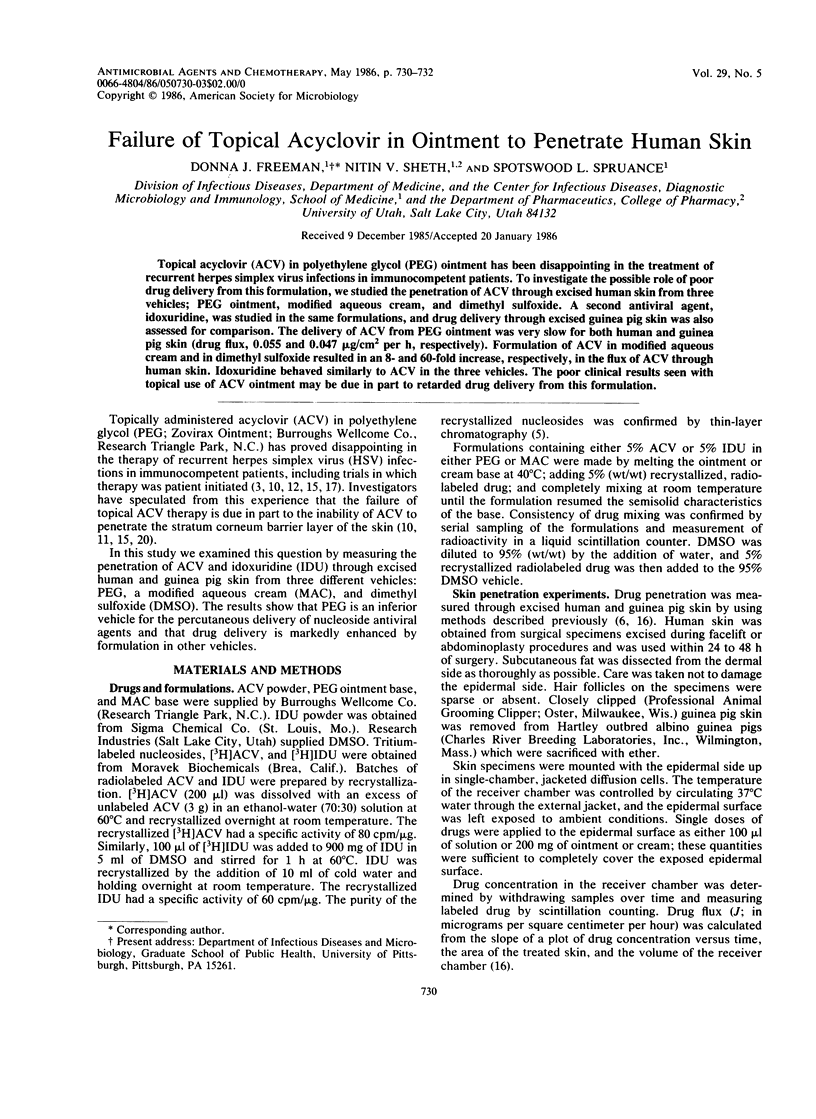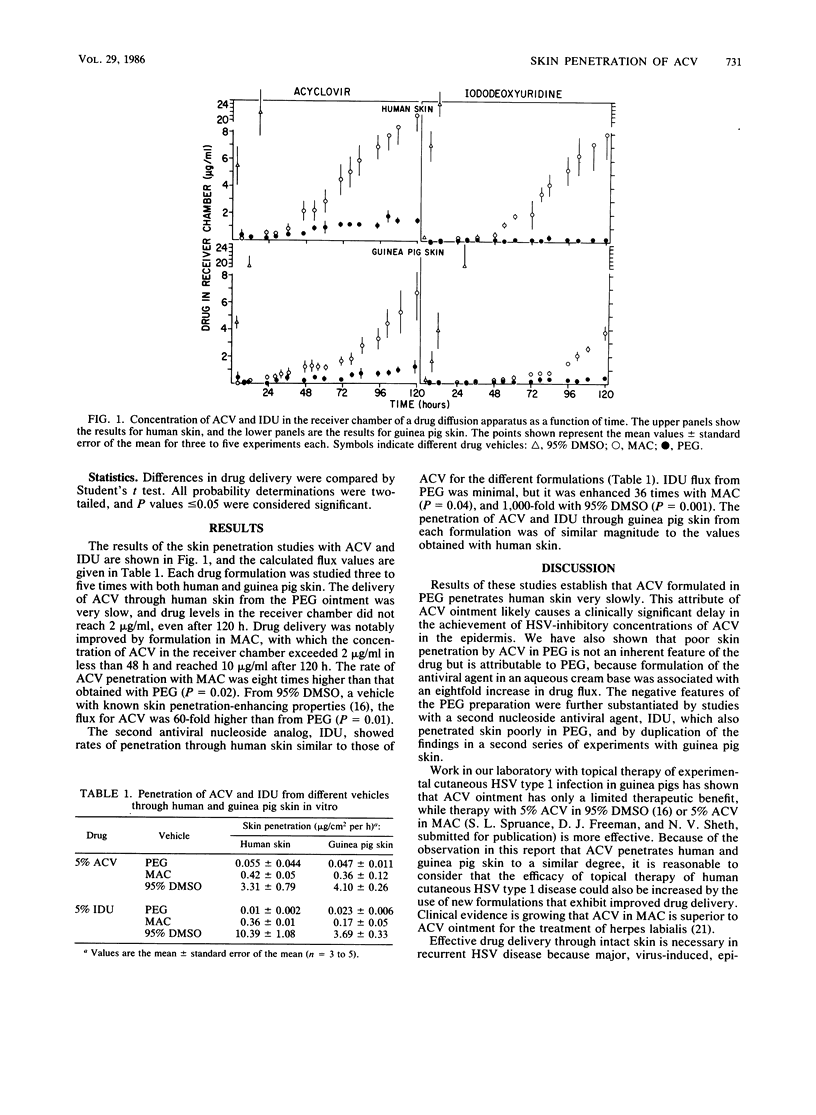Abstract
Topical acyclovir (ACV) in polyethylene glycol (PEG) ointment has been disappointing in the treatment of recurrent herpes simplex virus infections in immunocompetent patients. To investigate the possible role of poor drug delivery from this formulation, we studied the penetration of ACV through excised human skin from three vehicles; PEG ointment, modified aqueous cream, and dimethyl sulfoxide. A second antiviral agent, idoxuridine, was studied in the same formulations, and drug delivery through excised guinea pig skin was also assessed for comparison. The delivery of ACV from PEG ointment was very slow for both human and guinea pig skin (drug flux, 0.055 and 0.047 microgram/cm2 per h, respectively). Formulation of ACV in modified aqueous cream and in dimethyl sulfoxide resulted in an 8- and 60-fold increase, respectively, in the flux of ACV through human skin. Idoxuridine behaved similarly to ACV in the three vehicles. The poor clinical results seen with topical use of ACV ointment may be due in part to retarded drug delivery from this formulation.
Full text
PDF


Selected References
These references are in PubMed. This may not be the complete list of references from this article.
- Barrett C. W., Hadgraft J. W., Caron G. A., Sarkany I. The effect of particle size and vehicle on the percutaneous absorption of fluocinolone acetonide. Br J Dermatol. 1965 Nov;77(11):576–578. doi: 10.1111/j.1365-2133.1965.tb14578.x. [DOI] [PubMed] [Google Scholar]
- Corey L., Nahmias A. J., Guinan M. E., Benedetti J. K., Critchlow C. W., Holmes K. K. A trial of topical acyclovir in genital herpes simplex virus infections. N Engl J Med. 1982 Jun 3;306(22):1313–1319. doi: 10.1056/NEJM198206033062201. [DOI] [PubMed] [Google Scholar]
- Freeman D. J., Sacks S. L., De Clercq E., Spruance S. L. Preclinical assessment of topical treatments of herpes simplex virus infection: 5% (E)-5-(2-bromovinyl)-2'-deoxyuridine cream. Antiviral Res. 1985 Jun;5(3):169–177. doi: 10.1016/0166-3542(85)90049-x. [DOI] [PubMed] [Google Scholar]
- Freeman D. J., Spruance S. L. Efficacy of topical treatment for herpes simplex virus infections: predictions from an index of drug characteristics in vitro. J Infect Dis. 1986 Jan;153(1):64–70. doi: 10.1093/infdis/153.1.64. [DOI] [PubMed] [Google Scholar]
- Luby J. P., Gnann J. W., Jr, Alexander W. J., Hatcher V. A., Friedman-Kien A. E., Klein R. J., Keyserling H., Nahmias A., Mills J., Schachter J. A collaborative study of patient-initiated treatment of recurrent genital herpes with topical acyclovir or placebo. J Infect Dis. 1984 Jul;150(1):1–6. doi: 10.1093/infdis/150.1.1. [DOI] [PubMed] [Google Scholar]
- Reichman R. C., Badger G. J., Guinan M. E., Nahmias A. J., Keeney R. E., Davis L. G., Ashikaga T., Dolin R. Topically administered acyclovir in the treatment of recurrent herpes simplex genitalis: a controlled trial. J Infect Dis. 1983 Feb;147(2):336–340. doi: 10.1093/infdis/147.2.336. [DOI] [PubMed] [Google Scholar]
- Reichman R. C., Badger G. J., Mertz G. J., Corey L., Richman D. D., Connor J. D., Redfield D., Savoia M. C., Oxman M. N., Bryson Y. Treatment of recurrent genital herpes simplex infections with oral acyclovir. A controlled trial. JAMA. 1984 Apr 27;251(16):2103–2107. [PubMed] [Google Scholar]
- Sarkany I., Hadgraft J. W., Caron G. A., Barrett C. W. The role of vehicles in the percutaneous absorption of corticosteroids. An experimental and clinical study. Br J Dermatol. 1965 Nov;77(11):569–575. doi: 10.1111/j.1365-2133.1965.tb14577.x. [DOI] [PubMed] [Google Scholar]
- Spruance S. L., Crumpacker C. S., Schnipper L. E., Kern E. R., Marlowe S., Arndt K. A., Overall J. C., Jr Early, patient-initiated treatment of herpes labialis with topical 10% acyclovir. Antimicrob Agents Chemother. 1984 May;25(5):553–555. doi: 10.1128/aac.25.5.553. [DOI] [PMC free article] [PubMed] [Google Scholar]
- Spruance S. L., McKeough M. B., Cardinal J. R. Penetration of guinea pig skin by acyclovir in different vehicles and correlation with the efficacy of topical therapy of experimental cutaneous herpes simplex virus infection. Antimicrob Agents Chemother. 1984 Jan;25(1):10–15. doi: 10.1128/aac.25.1.10. [DOI] [PMC free article] [PubMed] [Google Scholar]
- Spruance S. L., Schnipper L. E., Overall J. C., Jr, Kern E. R., Wester B., Modlin J., Wenerstrom G., Burton C., Arndt K. A., Chiu G. L. Treatment of herpes simplex labialis with topical acyclovir in polyethylene glycol. J Infect Dis. 1982 Jul;146(1):85–90. doi: 10.1093/infdis/146.1.85. [DOI] [PubMed] [Google Scholar]
- Spruance S. L., Wenerstrom G. Pathogenesis of recurrent herpes simplex labialis. IV. Maturation of lesions within 8 hours after onset and implications for antiviral treatment. Oral Surg Oral Med Oral Pathol. 1984 Dec;58(6):667–671. doi: 10.1016/0030-4220(84)90031-8. [DOI] [PubMed] [Google Scholar]
- Tissot J., Osmundsen P. E. Influence of vehicles on the topical activity of fluorometholone. Acta Derm Venereol. 1966;46(5):447–452. [PubMed] [Google Scholar]
- Whitley R. J., Levin M., Barton N., Hershey B. J., Davis G., Keeney R. E., Whelchel J., Diethelm A. G., Kartus P., Soong S. J. Infections caused by herpes simplex virus in the immunocompromised host: natural history and topical acyclovir therapy. J Infect Dis. 1984 Sep;150(3):323–329. doi: 10.1093/infdis/150.3.323. [DOI] [PubMed] [Google Scholar]
- Yeo J. M., Fiddian A. P. Acyclovir in the management of herpes labialis. J Antimicrob Chemother. 1983 Sep;12 (Suppl B):95–103. doi: 10.1093/jac/12.suppl_b.95. [DOI] [PubMed] [Google Scholar]
- de Miranda P., Good S. S., Laskin O. L., Krasny H. C., Connor J. D., Lietman P. S. Disposition of intravenous radioactive acyclovir. Clin Pharmacol Ther. 1981 Nov;30(5):662–672. doi: 10.1038/clpt.1981.218. [DOI] [PubMed] [Google Scholar]


